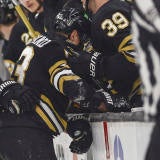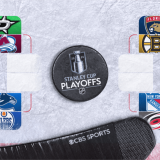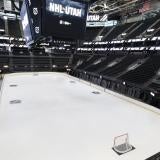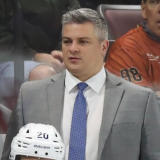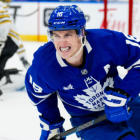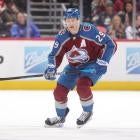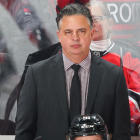
More NHL offseason: Rumors | Top 50 Free Agents | Buyout Tracker | Trades | Transactions
ARLINGTON, Va. -- One common theme this week when the American hopefuls for the Olympic team in Sochi this coming February was the ice. Specifically how it's bigger on the international level than where these guys play in the NHL almost exclusively.
It's an adjustment and anybody who tells you different isn't paying attention. It's rather clear that it has been an issue in the past as not only Team USA but Canada as well has struggled to perform well at the Olympics outside of the US. Granted, sometimes in North American have been on the international rink size but the struggles of two world hockey powers have been at least partially attributable to the size of the rink. Plain and simple, it's different.
Figuring out how to best employ your athletes and skill to the bigger ice will be one of the bigger issues facing the American staff as it prepares for Sochi. Do you favor players with a little more speed to take advantage of all the open ice? Do you give an edge to players with more experience on said surfaces? These are questions the staff will have to answer.
"North American teams have not done very well going overseas in the Olympic Games, it's not a good history," Team USA coach Dan Bylsma said this week. "The ice, the big ice surface are certainly things we talk about, the type of player we want and the type of player would be best over there and that's different than an NHL rink and the NHL game. That speed and skating, which we have in abundance of on our team but we have to play a different game. Here we like to play 'go, go go' but there has to be some aspect of patient, smart and intelligent hockey going over there on the bigger surface."
At some point, though, you run the risk of overthinking the issue. Whether the ice is 10 inches wider is 10 feet wider, the game remains the same. Bylsma pointed to the great basketball movie Hoosiers to make the point.
"In Hoosiers they went out and did the tape measure from the foul line to the basket [to show the court was the same size]," Bylsma said. "Both rinks between the dots is the same distance, between the hash marks it's the same distance."
Dustin Brown more or less echoed that sentiment.
"I've played enough hockey overseas, it's all the same. You still lace up your skates. Other than the ice being bigger, hockey is hockey."
So there's a balance. You have to take the bigger surface into consideration but not let it consume your thoughts. The game is different but it's not that different, good hockey players are good hockey players no matter the surface size.
Many of the players in contention for the US team have played for the national program before. Others played overseas in the lockout or played in the NCAA. That is to say just about every guy has had a little taste of what it's like on the big ice and some guys like Patrick Kane came to like what he saw.
"It was fun. It's fun having a little bit more time and space," Kane said. "It's almost one of those things where you're not worried about getting hit because players have to travel so far. It's always nice to have a little extra space especially as an offensive player. It will be really fun to play on the power play because that's where you see things really spread out; you see things like saucer passes, more shots from the slot which you don't see in the NHL."
Indeed, the game does tend to be less physical, something that high-energy forward T.J. Oshie lamented. That by itself might be as big of an adjustment as there is for the North Americans as the game on this side of the pond tends to be more physical (hence the genesis of the Europeans are soft stereotypes). That's one of the aforementioned adjustments that needs to be considered.
However players that need to make even bigger adjustments are the netminders. All of a sudden their crease feels bigger and they can find themselves swimming out of position.
"The biggest thing for the goaltender in getting into the game is angles," Ryan Miller said. "The boards are further to your left or your right but the paint is in the same spot. So you're going to feel like you're kinda drifting a bit. You're going to feel like you're giving up too much net to the short side but you're probably giving up the whole center of the net. It's just an awareness thing, you make the adjustments."
Is finding the right balance between the ice surfaces the single key to success for the States (and Canada) in the Olympics? Of course not, skill will always trump every other factor in such a debate. If you simply aren't good you stand little chance of winning.
However that doesn't mean it's not an important factor nonetheless. It was something the staff talked with the players about this week in Virginia and is something they are certainly considering. The real question is how much will it factor into not only the decision-making of the staff but how it will factor in to Team USA's fortunes in Russia.






